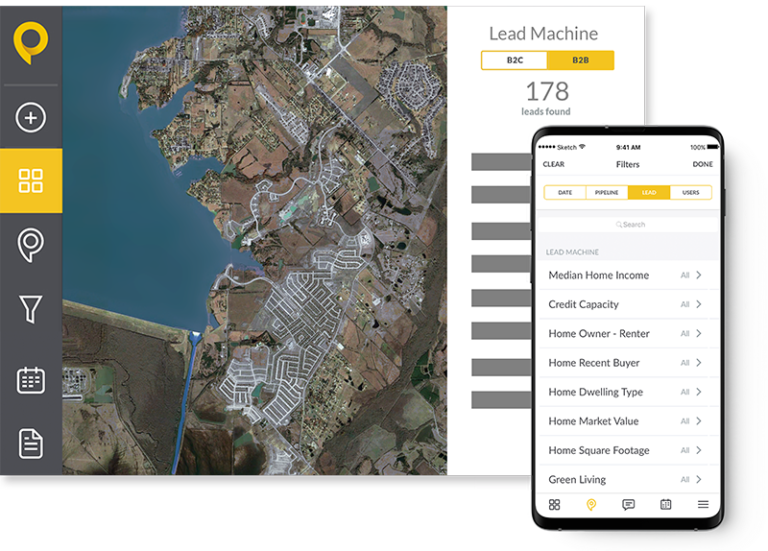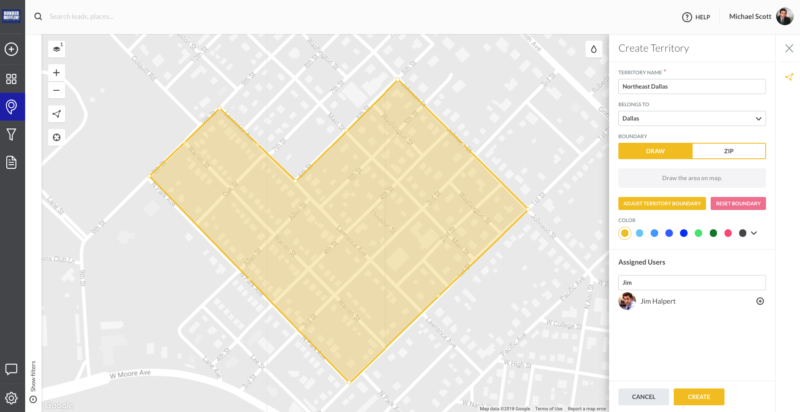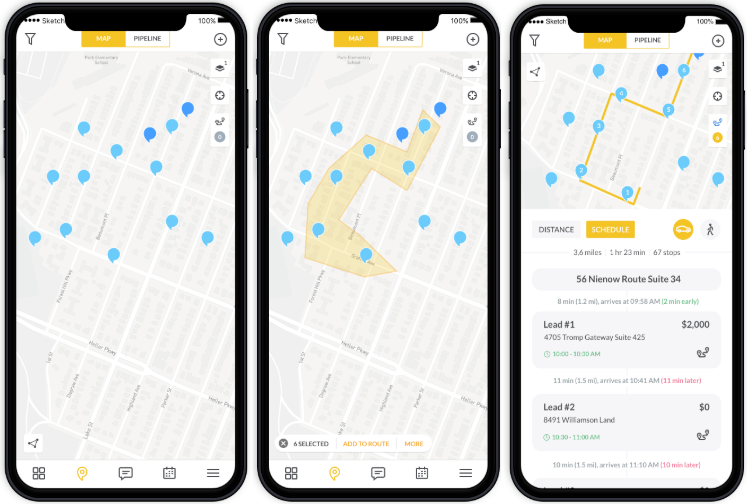Sales territory mapping is like drawing a treasure map for your sales team: except the treasure is revenue, and the map ensures everyone has a fair shot at finding it. By strategically dividing territories, you can eliminate redundancies, boost efficiency, and maximize sales performance. Modern sales territory mapping software makes this process faster and smarter.
In this guide, we’ll explore what sales territory mapping is, why it’s important, and how to optimize your territories for success.
What Is Sales Territory Mapping?
Sales territory mapping involves creating and assigning territories based on factors such as geography, revenue potential, and seller expertise. It’s giving each rep their own “sales sandbox” to play in, while ensuring everyone has the right resources and opportunities to succeed. Sales organizations can manually create maps or use mapping software to define territories and assign them.
Modern territory planning also considers account size to maintain balance. For instance, two large accounts might equate to four smaller ones in value. Managers can rebalance territories as needed to ensure fair opportunities for all reps to meet their performance metrics.
The Old vs. Modern Approach to Territory Mapping
Traditional methods like using Google Maps or manual tools are akin to navigating with an outdated paper map—you’ll get somewhere eventually, but you’re likely to take a wrong turn or miss key landmarks along the way. These approaches lack insights into prospects per region, account demographics, or alignment with your ideal customer profile (ICP).
Today, sales territory mapping software is the GPS of sales planning. It eliminates guesswork by providing data-driven insights that help design territories effectively, prevent disputes, and enable adjustments based on real-time data.

The Benefits Of Modern Sales Territory Management
Modern sales territory mapping tools offer several advantages:
- Strategic Assignments: Territory mapping platforms allow managers to segment territories based on multiple data points like rep experience level and market potential.
- Balanced Workloads: Territories are mapped considering factors beyond geography, such as lead volume and account size. As a result, a small territory could contain just as many leads as a region that spans multiple ZIP codes.
- Maximized Selling Time: Route optimization features simplify sales routes for reps, reducing travel time and increasing productivity.
- Enhanced Productivity: Digital maps integrate with CRM systems for instant access to data in the field, enabling reps to update notes via mobile devices and avoid manual entry.
4 Ways To Improve Territory Management
To save time, maximize resources, eliminate confusion, and increase performance, create territories for your team using the following strategies:
1. Target Market Demographics
Gather market demographics before sending your team out to knock on doors. This will minimize unproductive time in the field.
Use a tool like SPOTIO’s Lead Machine to identify and target qualified prospects that match your ideal customer profile (ICP) and ensure your team is targeting prospects that have real buying potential.

With SPOTIO, you can track the progress of each lead in your sales pipeline. This prevents leads that you’ve spent money on from slipping through the cracks and increases the return on your investment.
The more information you have about your current customer base, the better. You can understand where you’re having the most success and identify higher-quality potential buyers with a greater chance of buying.
2. Include Current Customers
Your current customers are like the foundation of a sturdy bridge—they support your business and pave the way for new opportunities. Beyond purchasing your product or service, they can provide some of the highest-converting and most cost-effective leads: referrals. All you have to do is ask.
Start by generating a list of all your current customers. If you’re using a sales intelligence tool like SPOTIO, uploading this list into your account is quick and easy. You can also sort pins in your account by the status you’ve created to signify a closed-won deal, giving you a clear visual representation of where your customers are located.

If you’re not using a sales tracking app, you’ll need to map these addresses manually. While this process may be more time-consuming, it’s worth the effort to gain insights into customer distribution and territory optimization.
Once you’ve mapped out all your customers, you can begin creating territories based on their locations. There are two effective strategies for this approach:
- Evenly distribute the number of customers in each territory to ensure fair workloads across your team.
- Assign smaller territories to reps if customers are more spread out, but still aim for equitable distribution to maintain balance and efficiency.
By leveraging your existing customer base strategically, you can unlock valuable referral opportunities while optimizing territory assignments for maximum impact.

3. Distribute By Number Of Prospects
Creating and assigning regions based on the number of contacts ensures that each sales rep has a fair and manageable workload, which is critical for optimizing performance.
Territory mapping software like SPOTIO simplifies this process by providing real-time data. As you draw a territory plan, SPOTIO calculates and displays the estimated number of prospects within each region, giving you actionable insights to make informed decisions.
This streamlined, data-driven approach allows you to create equitable territories for your entire team quickly and efficiently. In fact, with the right tools, you can design balanced territories in less than 10 minutes, ensuring your team is set up for success without wasting valuable time.
4. Distribute By City/ZIP Code
Assigning territories by city or ZIP Code is one of the simplest and most straightforward methods because it leaves no room for confusion. You can clearly define boundaries for your reps by saying, “This is your ZIP Code, and if you get a lead or sale outside of this region, it will go to the rep assigned to that territory.” This clarity eliminates overlap and ensures accountability.
These types of territories are typically larger and take longer to work through, making them ideal for long-term planning. Unlike smaller regions that may require frequent adjustments, city- or ZIP Code-based territories should remain relatively stable over time, allowing reps to focus on building relationships and maximizing opportunities within their assigned areas.
How To Evaluate And Optimize Sales Territories
Sales territories need regular evaluation to adapt to changing circumstances. Whether it’s shifting market dynamics, staffing changes, or competitive pressures, reviewing and optimizing territories ensures your team is set up for success. Here are three key areas to focus on when assessing your sales territories:
Consider Your Team’s Skills
Your team’s expertise and composition can significantly impact territory performance. For instance, a new hire with specialized knowledge might be better suited for a particular region, while the departure of a top-performing rep may require splitting their territory between two team members. Matching skills to territory needs ensures that each region is covered effectively and helps your team operate at its full potential.
Analyze Performance
Underperforming territories don’t always reflect poor sales rep performance. External factors such as shrinking budgets, shifting priorities among prospects, or increased competition could be responsible. For example, a competitor may have entered the region and captured market share, or economic changes may have reduced demand in certain industries. When a territory underperforms, it’s important to investigate thoroughly to identify the root cause and make informed adjustments.
Reassess Market Potential
Market potential can change over time due to economic shifts, demographic trends, or emerging opportunities. Reviewing sales data from the past year can help you identify patterns and forecast future potential within each territory. This analysis allows you to reallocate resources or redefine boundaries to focus on areas with the highest growth potential.
By periodically evaluating these factors, you can optimize your sales territories to align with current conditions and maximize your team’s performance. Regular reviews ensure your strategy remains agile and responsive to changes in the market.
3 Common Mistakes To Avoid In Territory Design
Designing effective sales territories is a critical step in optimizing your team’s performance, but it’s easy to make mistakes that can hinder success. To ensure your territory plan drives results and keeps your team motivated, avoid these errors:
1. Using Limited Data
Without accurate client or account data and the right tools, managers cannot effectively gauge rep performance or territory success. Relying on incomplete information can lead to poorly designed territories that fail to maximize potential. Investing in comprehensive sales mapping software ensures you have access to the insights needed to create balanced and effective territories.
2. Excluding Your Team
Your sales reps are the boots on the ground, and their firsthand knowledge of their regions is invaluable. Failing to involve them in territory planning can result in misaligned assignments and lower morale. When reps feel included in the process, they are more likely to take ownership of their territories and perform at their best.
3. Relying On Spreadsheets
Spreadsheets may seem like a simple solution for managing territories, but they lack the clarity and functionality needed for effective planning. They fail to provide clear visual boundaries for reps and make it difficult to analyze performance across regions. Instead, use sales mapping software that enhances visibility, simplifies collaboration, and provides actionable insights for better decision-making.
8 Reasons To Use Sales Territory Mapping Software
Sales territory mapping software serves as a “command center” for your field sales strategy, offering clarity, precision, and actionable insights that drive results. It simplifies the process of managing territories and equips your team with the tools they need to succeed. Here are the key benefits of using sales territory mapping software:
1. Prevent Deals From Falling Through
Balancing workloads ensures that no leads are overlooked. A well-designed platform helps you allocate territories fairly so reps can focus on every opportunity within their assigned regions.
2. Uncover New Leads Within Existing Territories
Before expanding into new areas, ensure your team has fully explored the potential within their current territories. Tools like SPOTIO provide detailed insights that help identify untapped opportunities, enabling your team to maximize existing regions without missing hidden prospects.
3. Save Time With Smart Segmentation
Creating sales maps manually can be time-consuming, but mapping software streamlines the process. Platforms like SPOTIO allow you to segment areas quickly based on factors such as sales potential, lead quality, or sales volume, saving valuable time for managers and reps alike.
4. Improve Close Rates With Data-Driven Assignments
Integrated data—such as historical performance, total revenue earned, and converted leads—allows you to assign reps strategically. Whether placing top performers in high-potential areas or giving newer reps opportunities to grow in manageable regions, data-driven assignments ensure optimal results.
5. Optimize routes and improve productivity
Territory mapping and route planning often operate as separate processes, but software like SPOTIO integrates them seamlessly. You can easily identify which territories generate the most deals or house high-value clients and adjust routes dynamically as new leads arise. This flexibility helps reps save time and focus on the most promising opportunities.

6. Measure Sales Data Across Territories
The best sales mapping tools make it easy to compare performance across regions visually. SPOTIO’s reporting features allow managers to identify which territories are generating the most deals, where high-value clients are located, and which areas may require additional support. These insights enable informed decision-making and resource allocation.

7. Boost Team Morale With Balanced Workloads
Uneven territory assignments—whether too small or too large—can frustrate your team and impact morale. Mapping software ensures workloads are distributed fairly by analyzing the effort required for each region. This balance fosters a sense of equity and keeps morale high among your reps.
8. Help Your Team Succeed
Sales mapping platforms like SPOTIO offer a suite of tools designed to help reps work smarter:
- Add notes about prospects directly from a mobile device
- Drop real-time location pins while following routes
- Automate reminders for follow-ups with leads
- Sync data remotely with your CRM
- Share notes and reports with team members
- Access a complete history of interactions with leads
These features reduce manual data entry and allow reps to focus on selling instead of administrative tasks.
Experience Productivity Powered by AI with SPOTIO for Sales Territory Mapping
Sales territory mapping software simplifies the process of organizing and managing territories while empowering your team to perform at their best:
- Organize and divide territories: Quickly define or reorganize territories with intuitive tools like SPOTIO’s interface.
- Visualize lead and customer data: Use color-coded map pins to track prospects, leads, and existing customers at a glance.
- Monitor performance: Access detailed performance metrics for individuals or teams within specific territories, helping you identify strengths and areas for improvement.
With SPOTIO’s advanced capabilities, field sales teams can stay organized, increase productivity, and close more deals. Take your sales strategy to the next level. Request a demo today.




